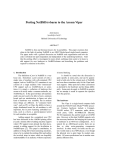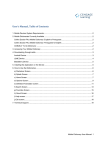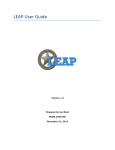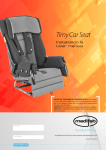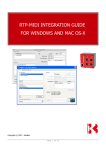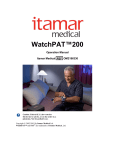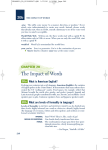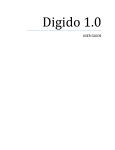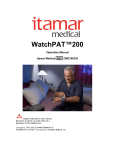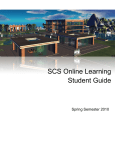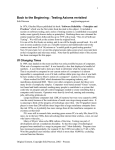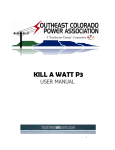Download User Manual - Emily Lagan`s Portfolio
Transcript
User Manual Prepared for: UNT English Department Prepared by: Emily Lagan TECM 2700.002 9:00-9:50 Terry Smith 2 May 2014 Table of Contents iii Table of Contents Table of Contents ........................................................................................... iii Introduction to MLA Manual ........................................................................... v Formatting Style ............................................................................................. 3 How to Format Paper ................................................................................... 3 How to Create a Header ............................................................................... 3 How to Start a Paper .................................................................................... 3 Citing Outside Sources.................................................................................... 7 How to Cite Outside Sources within the Text ................................................ 7 How to Create a Works Cited Page................................................................ 8 Creating the Works Cited Page ...................................................................... 11 How to Cite Books...................................................................................... 11 Single Author.......................................................................................... 11 Two or Three Authors ............................................................................. 11 Four or More Authors ............................................................................. 11 Unknown Author .................................................................................... 11 How to Cite Anthologies ............................................................................. 12 Entire Anthology ..................................................................................... 12 One or More Selections from an Anthology .............................................. 12 Editions after the First Edition ................................................................ 12 Selections from Editions after the First Edition of an Anthology .............. 12 Index ............................................................................................................ 13 Introduction to MLA Manual v Introduction to MLA Manual In this MLA manual, I will cover how to format your paper, how to cite sources within the text, and how to create a works cited page. I created this manual for students and professors of the humanities since I focus on how to use MLA style within an academic paper. Students use MLA (Modern Language Association) style for academic papers in high school and college. Professors and researches of the humanities use MLA for research papers, critical analysis, and any other academic paper. On the title pages for each chapter, I have included a sample document for the different topics. In chapter one, I will provide step by step directions on how to format a paper. On the title page, I have shown what the heading of the paper should look like. In chapter two, I will give examples on the different ways to cite a passage within a paper. On the title page, I have given an example on how to incorporate a quote into a paragraph. In chapter three, I will give examples on how to cite sources on a works cited page and describe how to create a works cited page. On the title page, I have given an example of a works cited page using the examples in the chapter. Formatting Style 1 inch margin 1 inch margin First 0.5 inches Last Name 1 and Last Name Professor Class Date Title Start paper here. Formatting Style Formatting Style How to Format Paper After opening Microsoft Word: 1. Choose the blank page option 2. Click the Page Layout tab on the top ribbon 3. Click Margins under Page Setup 4. Click Normal. Normal should create one inch margins on all sides of the document. 5. Click the Home tab on the top ribbon 6. Click the arrow in the bottom right corner of the Paragraph section on the top ribbon. A dialogue box should open. 7. Change line spacing to single or double 8. Check the box next to “Don’t add space between paragraphs” so the box is checked 9. Exit out of the dialogue box 10. Click the drop down option for fonts 11. Choose a font a. Times New Roman b. Arial c. Remember, you want the document to be easy to read 12. Choose point 12 font 13. Choose black color for the font (R=0 G=0 B=0) How to Create a Header 1. 2. 3. 4. 5. 6. 7. 8. Double click at the top of a page Set the justification to the right Type your last name Click the Design tab that is located under Header and Footer on the ribbon Click Page Number under the Header and Footer section on the left Hover over Current Position Click Plain Number Close out of Header and Footer. You can do this two ways: a. Double click outside of the Header and Footer b. Click “Close Header and Footer” under the “Header and Footer Tools” tab How to Start a Paper 1) Click the Home tab in the top ribbon 2) Click the Left Align in the Paragraph section 3) Create heading for paper a. Type first and last name in the first line b. Type professor’s name in second life (if applicable) 3 4 Modern Language Association Manual 4) 5) 6) 7) 8) 9) 10) c. Type class number and section in third line (ENGL 4195.001) d. Type date in fourth line (5 January 2012) i. For proper MLA style, the day comes before the month ii. For proper MLA style, the month is always spelled out Hit enter after the heading Click the Center Alignment in the Paragraph section. This applies to any papers outside of technical communication. Type title Hit enter Click on the Left Alignment in the Paragraph section Hit Tab Start paper Citing Outside Sources When you cite a source, you need quotes around what the other person said, and you need to include who wrote the original lines. This example is taken from Interview with a Vampire by Anne Rice. First, you must introduce the quote, whether you say “Anne Rice wrote” or you lead up to the quote. The vampires want to feel open yet still feel a part of something. “I saw a bird soaring out of a cave above the open sea” (Rice 238). Then you would talk about the quote and how the quote is important to your paper. Never end a paragraph with a quote from someone else unless the quote sums up the paragraph, and you do not need to explain what the quote says. Citing Outside Sources 7 Citing Outside Sources When you use outside sources, you have to cite everything that is not your own words. This includes paraphrasing what someone said. When you do not cite where the information came from, this is called plagiarism. How to Cite Outside Sources within the Text When you use outside sources, you will use passages from those sources. You have to give information about each passage and where it came from. You can do this are several ways: A) You can state the author (if the author is known) by saying he or she wrote, “Quote.” a. In The Vampire Lestat, Anne Rice said, “I saw a bird soaring out of a cave above the open sea” (238). b. “I saw a bird soaring out of a cave above the open sea,” Anne Rice wrote in The Vampire Lestat (238). B) You can state the author in the parenthetical citation. If you choose this way, you have to put the author’s last name in the parenthetical citation at the start of the paper. If you use more than one author, you put the author’s last name in the parenthetical citation each time you change which author you are working with. a. “I saw a bird soaring out of a cave above the open sea” (Rice 238). b. “I saw a bird soaring out of a cave above the open sea” (Rice 238). You put information that explains how this quote is relevant to the next quote and the main topic. “It is not impossible that my kangaroo has hidden them in her pouch,” (O’Brien 116). Each time you quote an outside within your text, you must have a parenthetical citation. A parenthetical citation tells the reader where in the source the reader can find the information. A) When using direct quotes a. The parenthetical citation comes at the end of the sentence before the period. Notice in the examples that the period always goes after the citation. i. “I saw a bird soaring out of a cave above the open sea” (Rice 238). ii. “It is not impossible that my kangaroo has hidden them in her pouch,” wrote O’Brien (116). b. The parenthetical citation includes the page number (if a print source) and the author of the source. B) When using paraphrases a. The parenthetical citation comes at the end of the paraphrase before the period of the last sentence of the paraphrase. i. Lestat saw the bird leave the open cave. To Lestat, the bird was terrifying (Rice 238). 8 Modern Language Association Manual ii. The Pooka argued that he always wears an odd number of short tails. He has a shirt made with two shirt tails so he always has three or more (O’Brien 116) C) When citing poems or verse play a. The parenthetical citation still comes at the end of what you quote. i. If it is a verse play, it will include act, scene, and line numbers (Shakespeare 4.1.23-43) ii. If it is a poem, it will include lines and will say lines inside the parentheses (lines 54-60) b. If you quote more than one line, you use a forward slash (/) to separate the lines. i. “A man may see how this world goes / with no eyes” (Shakespeare 4.2.148-49). ii. “No decree or creed can outlaw you / As you take every living thing apart” (Komunyakaa lines 13-14). How to Create a Works Cited Page Works Cited page will include all the outside sources you used throughout your paper. The Works Cited page comes at the end of your paper. At the end of your paper: 1) Click Page Layout tab on the top ribbon 2) Click Breaks 3) Click Page On the new page: 1) Click the Home tab on the top ribbon 2) Click Center Alignment in the Paragraph section 3) Type Works Cited 4) Hit enter 5) Click Left Alignment in the Paragraph section 6) Click the arrow in the bottom right corner of the Paragraph section. A dialogue box should open 7) Change Special to Hanging. Special is located under Indentation. 8) Exit out of the dialogue box On the Works Cited page, you will list all the outside sources you used throughout your paper. You will have to list all sources in alphabetical order by author’s last name. If the source does not have an author, you list the source by the title of the source. I will explain how to cite sources on the Works Cited page in the next chapter. Creating the Works Cited Page Works Cited Edgeworth, Maria. “The Limerick Gloves.” The Oxford Book of Irish Short Stories. Ed. William Trevor. New York: Oxford UP. 27-51. Print. .5 inches Harris, Charlaine, Patricia Briggs, James Grady, Heather Graham, Melissa Marr, et al. Home Improvement. Undead Edition. Ed. Charlaine Harris and Toni L. P. Kelner. New York: Ace Books, 2011. Print. Komunyakaa, Yusef. “Ode to the Maggot.” The Vintage Book of Contemporary American Poetry. Ed. J. D. McClatchy. 2nd ed. New York: Random House Inc., 2003. 538-39. Print. McClatchy, J. D., Ed. The Vintage Book of Contemporary American Poetry. 2nd ed. New York: Random House Inc., 2003. Print. McCloskey, Mary Lou, and Lydia Stack. Voices in Literature. Boston: Heinle, 1996. Print. New Concise World Atlas. New York: Oxford UP, 2007. Print. Rice, Anne. The Vampire Lestat. New York: Random House Inc., 1985. Print. Trevor, William, Ed. The Oxford Book of Irish Short Stories. New York: Oxford UP, 1991. Print. Creating the Works Cited Page 11 Creating the Works Cited Page As stated in “Citing Outside Sources,” I will explain how to cite the outside sources on the Works Cited page. You will need access to every source you have used in your paper. If you used an online database, you can have the information you need emailed to you. Some general guidelines for the Works Cited page include: Use author’s last name, first name Put all other authors with first name first if the work has more than one author List everything in alphabetical order Capitalize all major words of titles Use quotation marks for articles and short works Use italics for books and long works Give the city of publication without the state Use UP for university press Use the date on the title page for the date of publication. You can also use the most recent copy right date. Include the medium of the source How to Cite Books Single Author Author (last name, first name). Title. City of publication: publisher, date. Medium. Rice, Anne. The Vampire Lestat. New York: Random House Inc., 1985. Print. Two or Three Authors First author (last name, first name), and Second author (first name last name). Title. City of publication: publisher, date. Medium. McCloskey, Mary Lou, and Lydia Stack. Voices in Literature. Boston: Heinle, 1996. Print. Four or More Authors First author (last name, first name), other authors (first name last name). Title. Edition number. City of publication: publisher, date. Medium. Harris, Charlaine, Patricia Briggs, James Grady, Heather Graham, Melissa Marr, et al. Home Improvement. Undead Edition. Ed. Charlaine Harris and Toni L. P. Kelner. New York: Ace Books, 2011. Print. Notice the example has “Ed.” “Ed.” means “Edited by.” If the book lists an editor on the cover, you must include this in the citation. Unknown Author Title. City of publication: publisher, date. Print. New Concise World Atlas. New York: Oxford UP, 2007. Print. 12 Modern Language Association Manual How to Cite Anthologies Entire Anthology If the anthology has more than one editor, you will use “Eds.” instead of “Ed.” Editor (last name, first name), Editor (first name last name), Ed(s). Title of anthology. City of publication: publisher, date. Medium. Trevor, William, Ed. The Oxford Book of Irish Short Stories. New York: Oxford UP, 1991. Print. One or More Selections from an Anthology Author of selection (last name, first name). “Title of selection.” Title of anthology. Ed. Editor(s) names (first name last name). City of publication: publisher, date. Page(s) of selection. Medium. Edgeworth, Maria. “The Limerick Gloves.” The Oxford Book of Irish Short Stories. Ed. William Trevor. New York: Oxford UP. 27-51. Print. Editions after the First Edition Editor (last name, first name), Editor (first name last name), Ed(s). Title of anthology. Edition number. City of publication: publisher, date. Medium. McClatchy, J. D., Ed. The Vintage Book of Contemporary American Poetry. 2nd ed. New York: Random House Inc., 2003. Print. Selections from Editions after the First Edition of an Anthology Author of selection (last name, first name). “Title of selection.” Title of anthology. Ed. Editor(s) names (first name last name). Edition number. City of publication: publisher, date. Page(s) of selection. Medium. Komunyakaa, Yusef. “Ode to the Maggot.” The Vintage Book of Contemporary American Poetry. Ed. J. D. McClatchy. 2nd ed. New York: Random House Inc., 2003. 538-39. Print. Index 13 Index Anthology, 12 Cite, 7, 11, 12 Format, 3 Header, 3 Home, 3, 8, 9, 11 Left Align, 3 Margins, 3 Page Layout, 3, 8 Page Setup, 3 Paragraph section, 3, 4, 8 parenthetical citation, 7, 8 poems, 8 quote, 7, 8 Quote, 7 ribbon, 3, 8 verse play, 8 Works Cited, 8, 9, 11



















